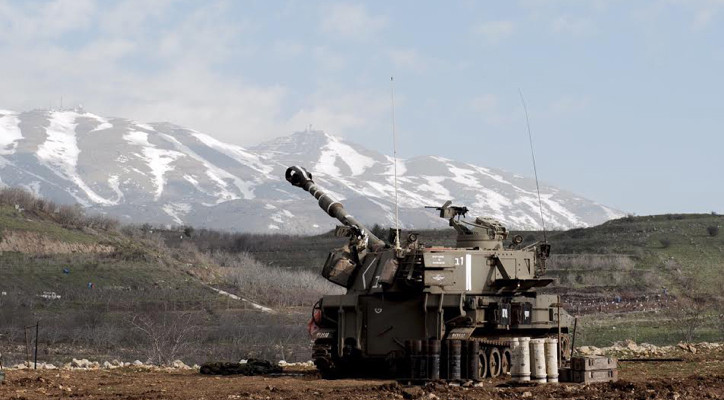By Jeffrey White
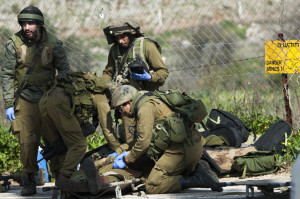
Israeli soldiers giving medical care after a Hezbollah attack. (Flash90)
Current expectations that the two sides can manage escalation may not hold true, and a new war would be more intense and destructive than in 2006.
On January 27, Hezbollah killed two Israeli soldiers in retaliation for the January 18 airstrike against its operatives in Syria, raising the potential for serious conflict to its highest level since the 2006 war. Although both sides are signaling that they are not interested in further escalation at the moment, future exchanges could rapidly devolve into all-out fighting. Furthermore, it is unclear whether Iran — which lost a prominent general in last week’s Israeli strike — views Hezbollah’s response as adequate, and it may yet prod the group toward further action.
WHAT HAS CHANGED SINCE 2006?
Over the past few years, Israel and Hezbollah have both worked to improve their capabilities for the kind of war they expect to fight. And Syria’s civil war has changed the strategic landscape greatly.
For its part, Hezbollah has massively expanded the size and range of its rocket and missile inventory. In 2006, it went to war with some 13,000 short- and medium-range rockets, allowing it to strike targets throughout northern Israel. Today it could have over 100,000 rockets and missiles, including a number of long-range systems as well as systems with improved accuracy, allowing it to strike throughout Israel and with increased precision.
Hezbollah is also believed to have made other improvements in its capabilities, including air defense and coastal defense, with systems acquired from or through Syria. It has very likely deepened and improved its antiarmor capabilities with additional antitank weapons. And it has improved its defensive layout in southern Lebanon, deeply embedding its offensive and defensive forces in various towns. In addition, the group claims to have developed a capability to undertake offensive ground operations into Israel. According to the director of production for Israeli military intelligence, Hezbollah forces may well penetrate the border and fight within northern Israel in the event of another war.
Hezbollah’s strategic situation has also changed following its commitment of significant forces to Syria, with an estimated 5,000 personnel serving there at any one time. On the one hand, this situation may dilute Hezbollah’s interest in serious conflict with Israel, since it limits the number of forces the group could bring to bear. On the other hand, Hezbollah does not appear to have committed the kinds of forces (rocket/missile and antitank) that would be most useful against Israel, and it has gained operational experience in Syria that could make it more effective in a ground war. Moreover, the group could attempt to exploit its new situation by operating through Syrian territory on Israel’s Golan front.
The Israel Defense forces have improved their capabilities dramatically since 2006 as well, including enhanced intelligence and strike firepower (air and artillery) that increase their ability to locate and hit targets. They have also enhanced their ground maneuver capabilities by deploying more advanced and capable tanks and armored personnel carriers (the Merkava IV and Namer, respectively) and equipping key armored units with the Trophy self-protection system, which can intercept antitank munitions. Since 2006, IDF ground training has emphasized operations against Hezbollah, though it is unclear how much of this has been done for reserve units.
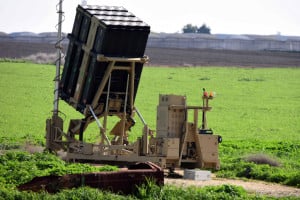
An Iron Dome battery. (Flash90)
Israel’s ability to defend against Hezbollah’s short-to-medium-range rocket threat has also been enhanced through deployment of the Iron Dome system, which did not exist in 2006. And its civil defense system has been upgraded and tested in recent conflicts with Hamas.
ESCALATION DYNAMICS
In addition to the unique tensions and triggers inherent in the Israel-Hezbollah situation, there are general military advantages to moving up the escalation ladder faster than one’s opponent. Doing so allows one to seize the initiative, dictate a conflict’s pace and scope, and execute one’s plans with fewer restrictions. There is definitely an advantage to being “first with the most.” Other factors that could lead to full-scale escalation include the snowballing of violence as each side ups its commitment, an incident that causes unexpected casualties, or domestic pressure to achieve victory.
Against these must be set certain brakes on escalation. For one, neither side can fully ignore its strategic situation, and neither seems eager to risk the extensive casualties and damage that all-out conflict could bring. Hezbollah’s Syrian commitment makes it less capable of sustained conflict with Israel, and pressure from allies could steer both parties away from escalation. Whether or not these brakes would be enough to prevent war remains to be seen.
LIKELY OPERATIONS
In the event of another large-scale fight, Hezbollah could conduct major offensive and defensive operations. Offensively, the centerpiece of its strategy could be a rocket and missile offensive throughout the depth of Israel. According to Israeli intelligence estimates, Hezbollah would likely attempt to sustain fire of around a thousand rockets and missiles per day, dwarfing the approximate daily rate of 118 achieved in 2006. Perhaps more important, Hezbollah now has missiles with the range and accuracy to strike large strategic targets such as airfields, headquarters, and economically important sites.
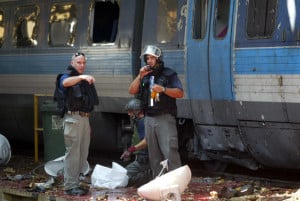
Police and medics inspect the site of a Hezbollah rocket attack. (Flash90)
An operation of this nature could overwhelm Israel’s antirocket systems. The weight of the attack would fall on northern and to a lesser extent central Israel, but Hezbollah can now reach targets in the south as well.
The group could also attempt to penetrate Israel via Lebanon or Syria. As mentioned above, Hezbollah has threatened to do so in a future conflict, Israeli intelligence has acknowledged the threat, and the group’s operations in Syria have probably given it a better capability to do so. In addition, last year’s Gaza war highlighted the threat of offensive cross-border tunneling. While conditions on the Lebanon border are not as suitable for that tactic, Israel is concerned about it and actively searches for tunnels there.
Defensively, Hezbollah would attempt to limit the effectiveness of expected Israeli air operations by dispersing its forces into civilian areas and/or underground, and by using whatever antiaircraft weapons it has, perhaps including new or improved types of surface-to-air missiles. It would also try to blunt any Israeli ground advance into southern Lebanon by relying on its fortified localities there and using antitank and indirect fire systems.
On the other side, Israel could carry out two major offensive operations:
An air operation against Hezbollah’s rocket/missile forces and infrastructure throughout Lebanon.
A large-scale, deep ground operation in which multiple divisions attack the group’s ground and rocket/missile forces in southern Lebanon.
The inability of airpower alone to negate the enhanced rocket/missile threat would likely make ground operations of some sort necessary.
Defensively, Israel would attempt to use active (Iron Dome and Patriot batteries) and passive (civil defense) measures to reduce the effects of Hezbollah’s rocket/missile offensive while waiting for IDF offensive operations to diminish the threat. This would likely mean destroying launch forces throughout Lebanon and seizing launch areas in southern Lebanon. Israel would also have to be prepared to fight on its own soil in the event of a successful penetration.
EFFECTS
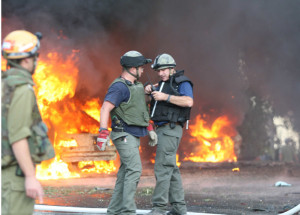
Israeli rescue workers are seen where a Hezbollah rocket landed. (Flash90)
A general conflict could be expected to produce significant military and civilian casualties on both sides. Fighting on the ground in southern Lebanon and perhaps northern Israel would likely produce the most military casualties. And if civilians were present amid ground operations — a likelihood in southern Lebanon — they would suffer significant casualties in those areas. Civilian casualties should also be expected in areas where air and rocket/missile strikes are conducted, especially when defense measures are inadequate.
Damage to civil infrastructure can be expected in both Israel and Lebanon. If Hezbollah can sustain high rates of fire on Israel, some weapons will get through and some targets will be struck, whether through sheer numbers or greater accuracy. And since Hezbollah operates from within civilian areas, Israeli strikes would cause some damage there even when precautions and precision tactics are employed. Lebanese infrastructure such as bridges, roads, and communications facilities would also be targeted because of their military utility.
Such a war would likely cause widespread social and economic disruption in Israel and Lebanon. Hamas was able to achieve this in southern Israel last year, and attacks further north showed the potential for countrywide disruption under sustained rocket fire. Similarly, the 2006 war demonstrated that Israeli air operations could reach deep into Lebanon with significant economic and social impact. A new war would likely bring more widespread air attacks with even broader effects.
POLITICAL AND STRATEGIC DIMENSIONS
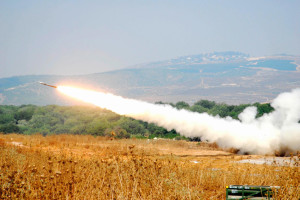
A rocket is launched against a Hezbollah target. (Flash90)
Accepting that Hezbollah, like Hamas, cannot be destroyed by military action alone, Israel would likely focus on achieving limited but clear strategic objectives in a new war, such as substantially reducing the group’s military capabilities and damaging enough infrastructure to sully its reputation as defender of Lebanon, perhaps increasing public antagonism toward it in the process.
Of course, critics within and outside Israel would protest these objectives for various reasons. And an extended conflict with significant casualties could increase pressure to expand the mission. A major conflict with Hezbollah could also complicate Israel’s relations with the United States. If Israel initiates large-scale operations, Obama administration sources might call for restraint, perhaps even painting the action as an effort to collapse the Iranian nuclear negotiations.
A major conflict would also have important implications for the Syria war. Fighting could spread into Syria along the Golan frontier and bring Assad regime forces under Israeli fire. Hezbollah could also be forced to withdraw troops from Syria in order to meet an Israeli offensive in southern Lebanon, weakening the critical support it has provided to Damascus. And if the group suffers major military losses to Israel, its long-term ability to lend such support could be compromised.
CONCLUSION
Current expectations that Israel and Hezbollah can manage escalation may or may not hold true; similar assessments were made before all of the recent Gaza conflicts (2009, 2012, 2014), and Hezbollah’s drastic miscalculation sparked the 2006 war. If a new conflict does in fact break out, Israel and Lebanon are in for a very difficult time. War in 2015 would probably be significantly more intense and destructive than in 2006, and all of Israel would likely be targeted, not just the north. Such a conflict would bring significant pressure to achieve a clear success, further driving the parties to sustain the fighting and raise it to higher levels of violence.
The author is a defense fellow at The Washington Institute for Near East Policy and a former senior defense intelligence officer.




